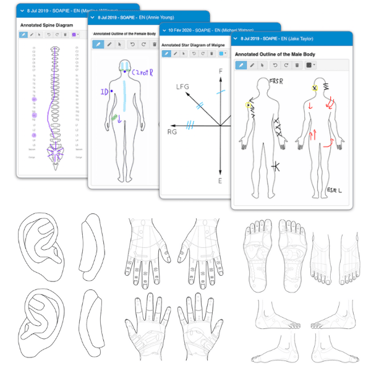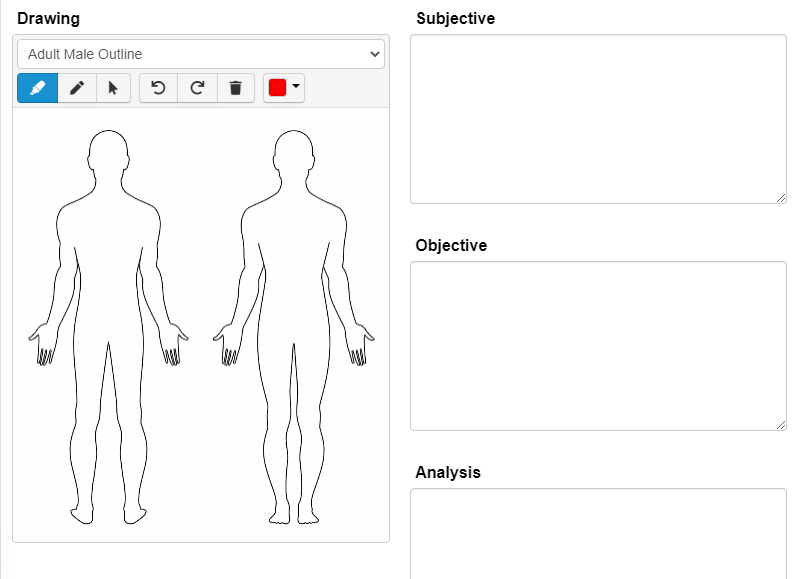Technology has taken a bigger place in our lives over the past year. With remote work, online medical records (EMRs) have become much more popular due to the need for professionals to have remote access to their patient's records.

What is an electronic medical record?
EMRs are electronic medical records, patient records usually from a health clinic, but they can be used by any service providers who need them. They may belong to clients of several practices such as chiropractors, dietitians, physiotherapists, and physicians, among others.
The contents of the EMRs include:
- Patient visit information (date, reason)
- Diagnostics
- Charts and diagrams
- Prescriptions
- Laboratory records
- Allergies
- Etc.
What's the difference between an EMR and EHR?
Electronic Medical Records (EMRs) are digital versions of patient records in a clinic or organization, and as mentioned above, they include multiple documents and records. They are also very confidential and are not shared externally, they can only be shared between professionals of a multidisciplinary clinic. The patient often has limited access.
Electronic Health Records (EHRs) are digital records of a person's health information, they can include medical history and assessment notes, for example. They can also be shared with professionals at another clinic. The patient can often access it online to view their results, in the form of a patient portal.
History
Electronic medical records began in 1972 in the United States, their usage costs were very high, so they were used primarily by government hospitals1. It was predicted that by the year 2000 all medical records would be available online, but that did not happen.
When GOrendezvous was created in 2012, the demand for EMRs was rather low, we were only specialized in booking online appointments back then. When we saw that this request became more popular we decided to add it to our service in 2019.
Although electronic records have been progressively more popular over the past 10 years, the pace has accelerated during the pandemic. Several clinics began to offer online appointments and computerized their records. EMRs are now much more detailed and feature several customizable options to meet the needs of various professionals.

How to use EMRs?
As previously mentioned, hospitals were the first to want to upload their records, which is normal given the number of people who need to view patient records and add notes to them.
Then, medical clinics followed, and now medico-aesthetic clinics, massage therapists, psychotherapists, speech therapists, remedial teachers, and more use EMRs. Several platforms now offer the creation and modification of medical records, GOrendezvous is one of them.
The benefits of electronic medical records
- Fewer errors: the information is all in one place, it is not handwritten, and it’s standardized, so there is less chance of errors for allergies, drug dosages, etc.
- Save time: you save time because the data is entered in the right place and thanks to its simplified options such as health questionnaires sent in advance, lexicons, shortcuts, as well as the electronic signature to complete the form.
- File sharing: multidisciplinary clinics can share common patient files, which greatly simplifies their work. Access is customizable to maintain the necessary confidentiality.
- It's safe: access is controlled by the administrator and no one else will be able to read the content. It is also possible to track all future modifications, which is frequently required by professional orders or associations.
- Less paper: it's better for the environment and saves you money on paper and printing costs.
- Besides: most of the software and platforms that offer EMRs also offer a range of features to run your business, such as online appointment scheduling, income reports, and online payments. It is possible to have a complete follow-up of the patient's medical file and payments in the same place.

How to choose your EMR platform?
1.
Security: it shouldn't be easy for anyone to gain access to your electronic medical records. Likewise, their confidentiality within your practice is important. Don't hesitate to ask questions about the cybersecurity of your electronic medical records software. Here are some ideas of what you can ask your provider:
- Where are the computer servers located?
- Can I manage the sharing of files with other colleagues?
- Is the data encrypted?
- Do the records comply with standards in place, such as Canada's Personal Information Protection and Electronic Documents Act (PIPEDA)?
A good EMR platform should allow you to issue permissions to your employees to control access to patient records.
2. Determine your needs: platforms offering EMRs are often quite different. Many are specialized for physicians only, others, like GOrendezvous, offer several options including booking appointments and online payments. Think about what your practice needs and how a platform can help you save time.
3. The costs: costs are also quite different depending on the related options, such as the number of users. At GOrendezvous the addition of the EMR option is at a cost of $20 per user.
With all of this information in hand, you can now make an informed choice about adding an electronic medical record system to your practice!
References
https://www.businessnewsdaily.com/10914-best-electronic-health-records-systems.html
https://www.healthit.gov/faq/what-electronic-health-record-ehr
https://elearning.scranton.edu/resource/health-human-services/emr_the-progress-to-100-percent-electronic-medical-records
https://www.extractsystems.com/healthydata-blog/2016/9/30/a-brief-history-of-the-emr
- https://infoway-inforoute.ca/fr/solutions/fondements-de-la-sante-numerique/dossiers-medicaux-electroniques